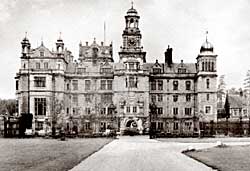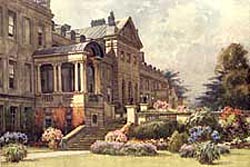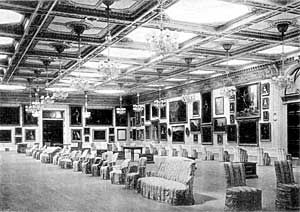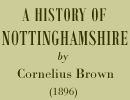< Previous | Contents | Next >
Thoresby Hall and Welbeck Abbey

Thoresby Hall, c.1920.
About three miles from Clumber is another splendid residence — Thoresby — once the home of the Duke of Kingston, from whom, as our references to Holme Pierrepont show, the present noble owner, Earl Manvers, is descended. The original mansion was destroyed by fire in 1745. It had been enlivened by the presence of the celebrated Lady Mary Wortley Montagu and other eminent personages, and was a solid substantial structure. The Duke of Kingston replaced the old house, but his brick mansion has in its turn given way to a glorious dwelling of Steetley stone in the Elizabethan style of architecture, which will ever remain a monument to the munificence and good taste of the present estimable Earl, to whom it owes its inception and construction. In the apt words of Mr. Robert White, ‘it may be considered as one of the most splendid modern additions to the long roll of baronial homes that dot the land so pleasantly, and which, with their parks and avenues, give us some of the finest thoughts of England and its people in their national home-like character.’
Leaving the sweeping, well-kept roads of the beautiful Thoresby estate by the picturesque ‘Buck Gates,’ and passing thence through the forest, amid oaks, knotted and gnarled, that have borne the fierce storms of many centuries, we reach the famous domain of Welbeck, the Nottinghamshire seat of the Duke of Portland. The mansion occupies the site of an abbey of Premonstratensian canons, founded by Thomas de Cuckney in 1140, and dedicated to St. James. The abbey was enriched by liberal gifts from the Goushills, D’Eyncourts, Bassets, and other county people of that day; and it also received a considerable grant from Edward I. With so much wealth at his disposal, the Abbot of Welbeck was an influential man, and to his custody in 1512 all the houses of the same order of the religious were entrusted. On the dissolution of the monastery, the site was granted by Henry VIII. to Richard Whalley, of Screveton, and his heirs, and after passing from them to other owners, it came into the hands of Sir Charles Cavendish, youngest son of the Countess of Shrewsbury, whose son entertained James I. there, and was raised to the peerage. As Baron Cavendish and Earl of Newcastle, he rendered eminent services to Charles I. during the Civil Wars, and was Commander-in-Chief of the Forces North of the Trent.
 The north front of Welbeck Abbey in 1910.
The north front of Welbeck Abbey in 1910.In 1642, when the Queen arrived with arms and ammunition, he made arrangements for her reception, and conducted her in safety to the King at Oxford. At the Restoration he was raised to the dignity of Duke of Newcastle, and spent the remnant of his days in retirement at Welbeck, which he had rebuilt and beautified, while his wife devoted herself to writing plays and poems and a life of her husband. The Duke’s great-granddaughter married the second Earl of Oxford, as the peerages testify; and their only daughter married William Bentinck, second Duke of Portland, in 1734, and so brought the estate to the noble family who still possess it.
Few houses in the country contain such wonders as are to be found at Welbeck. There is now but an insignificant trace left of the remains of the old Premonstratensian abbey; but the catacombs, or underground apartments, built at the instance of the last Duke, fill the visitor with astonishment, only tempered with delight, that these spacious halls beneath the surface of the earth should be so beautifully adorned, and in them so many choice works of art.
A labyrinth of tunnels communicates with various parts of the Welbeck estate. The new riding-school and tan gallop, the stables, farm outbuildings, where many prize cattle are housed, the gardens and conservatories, are all on a scale of almost unparalleled grandeur; and since the marriage of the sixth Duke, one of the most popular and respected noblemen in the country, the glories and hospitality of Welbeck are often enjoyed by many distinguished visitors.

Picture Gallery at Welbeck Abbey, c.1900.
It would occupy much space to enter into a detailed description of the house; and as the guide-books and newspapers afford so many details, it is needless to do so. One brief quotation will sufficiently indicate the grandeur of the subterranean portion of this remarkable mansion. ‘The underground apartments,’ says an observant visitor, ‘are nobly planned and proportioned. and for chasteness and elegance of decoration could hardly be surpassed. All the workmanship is curiously perfect. The walls are not only of vast thickness, but so treated with asphalt as to make the penetration of damp next to impossible. The doors, of enormous size and weight, are so perfectly hung that a child could open or shut them, and they close with the beautiful precision of those in the private drawing-rooms of Windsor Castle—that is to say, as accurately as a Scotch snuff-box. Even by the comparatively dim light of a winter afternoon this magnificent suite of apartments is perfectly lighted from above, and an effective side-light is obtained from a glass-roofed corridor running on one side. Both library, writing-rooms, billiard - rooms, and reception-rooms are finished and prepared for lighting by gas in the night-time. Equally notable is the magnificent ballroom, 160 feet long, lighted by day by gigantic bull’s-eyes, and at night by gas. It is difficult to imagine a more perfect apartment for the purpose of festivity. Its tasteful decorations have a light and elegant effect, and the arrangement of corridors, conservatories, and refreshment - rooms, and the devices which secure efficient ventilation, are as well and carefully thought of as the spacious "lifts" for raising ample but weary parents to the upper air. It is, moreover, admirable in its acoustic qualities, which is more than can be said for many of the music-rooms in great houses. A vast quantity of iron girders has been used in the construction of these subterranean apartments, which have been actually excavated out of the foreground of the abbey. There can be no doubt that they successfully supply the purpose for which they are intended, novel as the scheme of underground libraries and ball-rooms may appear at first sight.’
